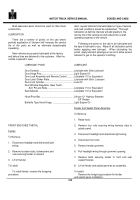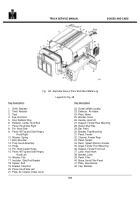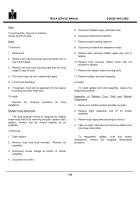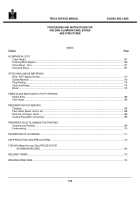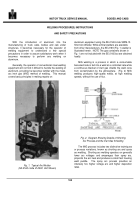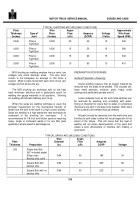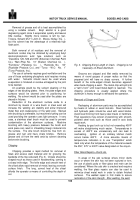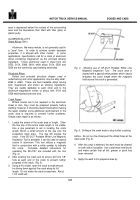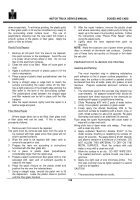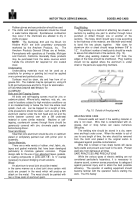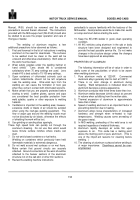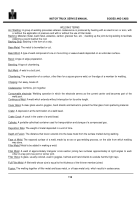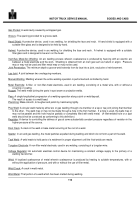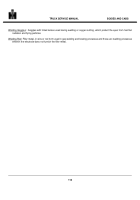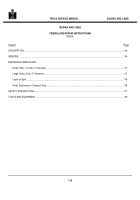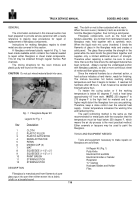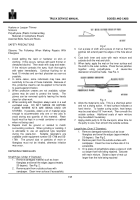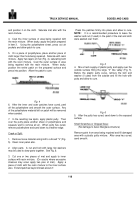TM-5-3805-254-14-P-2 - Page 111 of 894
MOTOR TRUCK SERVICE MANUAL
BODIES AND CABS
down excessively.
To minimize grinding, the plastic putty
or fiber glass patch or fill can be smoothed very nearly to
the surrounding metal surface level.
The use of
polyethylene sheeting over the new patch will impart a
smooth surface to the plastic or fiber glass.
Apply the
patch or filler as follows:
Plastic Putty Repairs
1.
Remove all old paint from the area to be repaired.
Use paint remover or fine sandpaper.
Avoid the use
of a power driven emery wheel or disc.
Do not use
files on the aluminum surfaces.
2.
Clean the area to be filled.
Wipe off loose paint or
dust.
3.
Apply a sufficient amount of plastic putty to fill the
dent or depression.
4.
Place a piece of plastic sheet (polyethylene) over the
plastic putty.
5.
Using a straight edge or edge bent to match the
surface surrounding the repair, strike off the filler.
Use a light pressure on the straight edge working the
filler down to the level of the surrounding surface.
The polyethylene sheet between the straight edge
and filler material can be left in place until the filler
hardens.
6.
After the repair hardens, lightly sand the repair to a
feather edge and paint.
Fiber Glass Repair
Where larger dents are to be filled, fiber glass cloth
or fiber glass mat can be used.
If this is required,
proceed as follows:
1.
Remove paint from area to be repaired.
The paint must be removed well back from the area to
be covered with fiber glass since fiber glass will not
stick to painted surfaces.
2.
Wipe the area to be repaired with clean cloth to
remove loose paint or dust.
3.
Prepare the resin mix according to instructions
furnished with the fiber glass kits.
4.
Cut a piece of plastic sheet (polyethylene)
considerably larger than the repair area.
5.
Prepare a patch consisting of fiber glass cloth or mat
saturated with resin and of sufficient quantity to
nearly fill the repair.
6.
Place the patch mixture on the plastic sheet and
position the mix over the indented area.
7.
Using a straight edge, smooth the patch mix to fill
the depression.
Leave the plastic sheet in position
until the fiber glass hardens.
8.
After the repair hardens, remove the plastic sheet
and where necessary, apply plastic putty to bring the
repair up to the level of surrounding surfaces.
Follow
the instructions under "Plastic Putty Repair" when
using the plastic putty.
9.
Lightly sand the area repaired--then paint as
required.
NOTE
:
Avoid the excessive use of power driven grinding
discs or wheels on aluminum cab surfaces.
Careless
use of these tools can quickly cut through or thin down
the cab skin.
PREPARATION OF ALUMINUM FOR PAINTING
Cleaning and Painting
The most important step in obtaining satisfactory
paint adhesion is that of proper surface preparation.
In
every case, the surface to be primed or painted should
be cleaned free from all oxide, scale, dirt, grease, oil and
moisture.
Prepare unpainted aluminum surfaces as
follows:
1.
The chemicals used in this process may discolor top
coat enamels.
All adjacent enamel finish should be
protected from direct exposure to the chemicals by
masking with paper or polyethylene sheeting.
2.
Dilute "Alumiprep #33" with Z parts of water before
using.
Use a plastic, porcelain or glass vessel.
3.
Freely apply the diluted Alumiprep #33 to the
aluminum surface by swabbing with a brush, mop, or
cloth, Swab surface for about 30 seconds, Re-apply
Alumiprep and swab for an additional 30 seconds.
Flush away the spent Alumrniprep with clean water or
wipe with a clean wet cloth.
Wring cloth free of clean water and rewipe.
Then wipe
with a clean dry cloth.
4.
Apply undiluted "Brush-On Alodine #1201" to the
metal surface, brushing or swabbing the surface for
about 30 seconds.
Re-apply Alidone #1201 liberally
and allow to remain for a minimum of 2 minutes.
DO
NOT ALLOW THIS MATERIAL TO DRY ON THE
METAL SURFACE.
Flush the surface with cold
water or mop with a clean wet cloth.
5.
Allow the surface to air dry.
DO NOT WIPE DRY.
The treated aluminum surface should now have a
gold hue.
6.
Apply one light coat of zinc chromate primer.
The
first coat of primer may be lightly sanded if a second
coat is to be applied.
CAUTION
1.
The processing materials are acidic.
109
Back to Top


